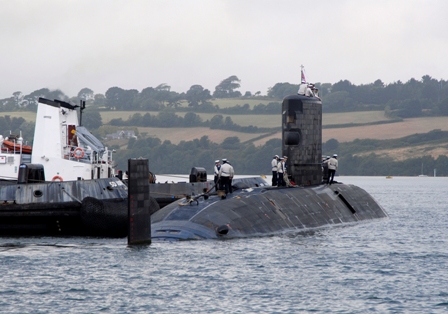 Contracting for Availability was introduced to improve in-service submarine maintenance schedules and control costs for the Royal Navy. Here, MOD DCB examines how CfA is helping a joint Babcock/MOD team deliver the Trafalgar Class operational programme by providing greater assurance of submarine availability and affordability.
Contracting for Availability was introduced to improve in-service submarine maintenance schedules and control costs for the Royal Navy. Here, MOD DCB examines how CfA is helping a joint Babcock/MOD team deliver the Trafalgar Class operational programme by providing greater assurance of submarine availability and affordability.
Trafalgar Class submarine maintenance is being optimised and maintenance costs reduced under the new ‘Contracting for Availability’ (CfA) approach, introduced in 2010, to T-Class in-service support at Babcock’s Devonport Royal Dockyard by a joint Ministry of Defence and Babcock team.
The CfA agreement focuses on improving adherence to the schedule of maintenance projects for in-service submarines to meet the availability demands of the Royal Navy’s operational programmes, while also improving affordability. The joint Babcock/MOD project team has worked closely together to identify, manage and improve any factors that impact on delivering this.
Following the initial introduction of CfA for the Trafalgar Class boats (a first for the submarine community), a four per cent improvement was seen by spring 2012. By April this year SSN schedule adherence had shown further improvement still. CfA has since been rolled out at Clyde for other submarine classes.
Pleased with the results, MOD In-Service Submarines (ISM) Team Deputy Head, Programme, Capt Mike Robinson, said: “CfA has promoted a beneficial cultural change whereby Babcock and the MOD work together to de-risk delivery of the submarine programme, today and into the future.”
Having established availability requirements, the identification of factors hindering delivery (including emergent defects, changes in the supply of materials and spares, changes to scope, issues around manpower availability, among others) enables these factors to be addressed via a joint improvement programme. Furthermore, a key element of CfA has been to move to a positive performance-based commercial arrangement that is centred on incentivising and rewarding improved delivery and availability, and encourages partnering behaviours and relationship development.
Recent examples have been seen in the Long Assisted Maintenance Periods With Dockings (known as LAMP(D)s), on HMS Tireless and HMS Triumph, which were undertaken by Babcock in response to revised MOD requirements to meet future submarine operational commitments, in parallel to the Revalidation Assisted Maintenance Period (RAMP) on HMS Torbay.
The unusual inclusion of a docking period within a LAMP enabled essential condition monitoring and maintenance of the submarine structure and systems that would otherwise have been inaccessible, and a significant number of hull and system surveys were undertaken to revalidate the platform as safe for continued operations. Standard system and equipment maintenance packages were also undertaken in conjunction with the rectification of both known and emergent defects. The complete overhaul of the starboard circulating water system completed on HMS Triumph (a job only previously undertaken during a more substantial RAMP) is an example of the magnitude of the activities undertaken in these LAMP(D)s.
In order to undertake these significant workscopes and maintain adherence to schedule, rigorous application of project management principles such as change and configuration management was particularly important due to the compressed timeframes associated with the key phases. Among the challenges faced from the outset was that of defining the work breakdown structure to meet the technical requirements of the submarine design authority while managing project risk and delivering an achievable yet ambitious programme.
During the LAMP(D) the primary challenge was to drive uncertainty out of the work requirement as a result of the extensive survey package, and continual review of emergent work requirements to assess the impact on the programme component packages and manage the overall schedule was key. Effective communication by the Joint Project Team with all stakeholders was also vital to ensure the most efficient flow of information to resolve any issues and drive the project programme. Additionally, prompt response to technical challenges in the maintenance of the systems was fundamental to enabling targets to be met in the final stages of the projects.
Both LAMP(D)s were successfully delivered to quality and programme, and illustrate the successful management of factors that may traditionally have caused delays – central to the success of the Contracting for Availability approach in de-risking delivery of the submarine programme and providing greater assurance of submarine availability.
Gavin Leckie, Babcock Submarine Programme Director, said: “Contracting for Availability has introduced a common currency for everyone involved in delivering submarine output, and has had the effect of promoting a learning culture to ensure that the cause of losses of submarine availability are understood and actions put in place to prevent reoccurrence. Ultimately the goal of CfA is to deliver greater assurance of submarine availability at reduced cost, on a sustainable basis, via a performance-driven and incentivised relationship that makes best use of Babcock and MOD resources.
“Collectively we have achieved above baseline performance levels every year since CfA was introduced, and will continue to look for further improvements year on year.”
For more information visit: www.babcockinternational.com
